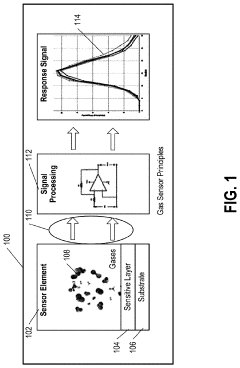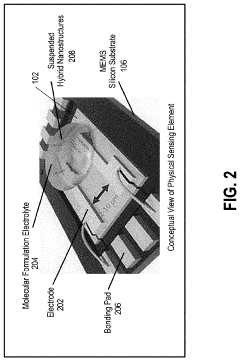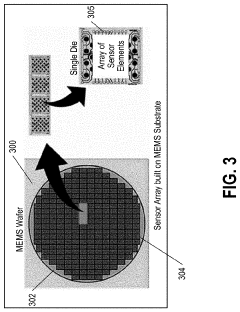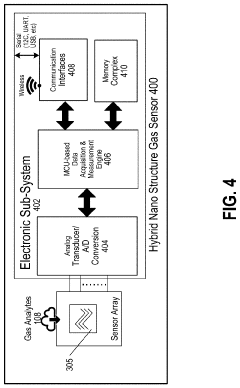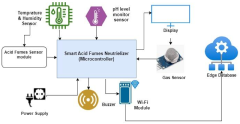What are the Health Risks Associated with Muriatic Acid Fumes?
JUL 18, 20259 MIN READ
Generate Your Research Report Instantly with AI Agent
Patsnap Eureka helps you evaluate technical feasibility & market potential.
Muriatic Acid Fumes: Background and Health Concerns
Muriatic acid, also known as hydrochloric acid, is a strong and corrosive mineral acid widely used in various industrial and household applications. Its chemical formula is HCl, and it is characterized by its pungent, irritating odor and highly reactive nature. In its pure form, muriatic acid is a colorless, transparent liquid that readily vaporizes when exposed to air, forming potentially hazardous fumes.
The use of muriatic acid dates back to the alchemists of the Middle Ages, who referred to it as "spirit of salt." Today, it plays a crucial role in numerous industries, including metal processing, water treatment, and chemical manufacturing. In residential settings, it is commonly employed for cleaning purposes, particularly in pool maintenance and masonry work.
Despite its utility, muriatic acid poses significant health risks, especially when its fumes are inhaled. The primary concern stems from the acid's corrosive nature and its ability to rapidly react with moisture in the air and on bodily surfaces. When muriatic acid fumes are released into the environment, they can cause immediate and severe irritation to the eyes, nose, throat, and respiratory system.
Short-term exposure to muriatic acid fumes can result in a range of symptoms, from mild irritation to more severe health effects. Common immediate reactions include coughing, chest tightness, shortness of breath, and a burning sensation in the throat and nasal passages. In higher concentrations or with prolonged exposure, the fumes can cause pulmonary edema, a potentially life-threatening condition where fluid accumulates in the lungs.
Long-term health concerns associated with chronic exposure to muriatic acid fumes are equally alarming. Repeated inhalation can lead to chronic bronchitis, erosion of dental enamel, and increased susceptibility to respiratory infections. In some cases, prolonged exposure has been linked to the development of occupational asthma and other chronic lung diseases.
The severity of health effects depends on several factors, including the concentration of the fumes, duration of exposure, and individual susceptibility. Individuals with pre-existing respiratory conditions, such as asthma or chronic obstructive pulmonary disease (COPD), are particularly vulnerable to the harmful effects of muriatic acid fumes.
Given these health risks, proper handling and safety measures are crucial when working with muriatic acid. This includes adequate ventilation, the use of appropriate personal protective equipment (PPE), and strict adherence to safety protocols. Understanding the potential health hazards associated with muriatic acid fumes is essential for both industrial workers and homeowners to ensure safe usage and minimize the risk of adverse health effects.
The use of muriatic acid dates back to the alchemists of the Middle Ages, who referred to it as "spirit of salt." Today, it plays a crucial role in numerous industries, including metal processing, water treatment, and chemical manufacturing. In residential settings, it is commonly employed for cleaning purposes, particularly in pool maintenance and masonry work.
Despite its utility, muriatic acid poses significant health risks, especially when its fumes are inhaled. The primary concern stems from the acid's corrosive nature and its ability to rapidly react with moisture in the air and on bodily surfaces. When muriatic acid fumes are released into the environment, they can cause immediate and severe irritation to the eyes, nose, throat, and respiratory system.
Short-term exposure to muriatic acid fumes can result in a range of symptoms, from mild irritation to more severe health effects. Common immediate reactions include coughing, chest tightness, shortness of breath, and a burning sensation in the throat and nasal passages. In higher concentrations or with prolonged exposure, the fumes can cause pulmonary edema, a potentially life-threatening condition where fluid accumulates in the lungs.
Long-term health concerns associated with chronic exposure to muriatic acid fumes are equally alarming. Repeated inhalation can lead to chronic bronchitis, erosion of dental enamel, and increased susceptibility to respiratory infections. In some cases, prolonged exposure has been linked to the development of occupational asthma and other chronic lung diseases.
The severity of health effects depends on several factors, including the concentration of the fumes, duration of exposure, and individual susceptibility. Individuals with pre-existing respiratory conditions, such as asthma or chronic obstructive pulmonary disease (COPD), are particularly vulnerable to the harmful effects of muriatic acid fumes.
Given these health risks, proper handling and safety measures are crucial when working with muriatic acid. This includes adequate ventilation, the use of appropriate personal protective equipment (PPE), and strict adherence to safety protocols. Understanding the potential health hazards associated with muriatic acid fumes is essential for both industrial workers and homeowners to ensure safe usage and minimize the risk of adverse health effects.
Market Analysis of Muriatic Acid Usage
The market for muriatic acid, also known as hydrochloric acid, has shown steady growth in recent years due to its widespread applications across various industries. The global hydrochloric acid market was valued at approximately $7.3 billion in 2020 and is projected to reach $8.9 billion by 2027, growing at a compound annual growth rate (CAGR) of 3.2% during the forecast period.
The construction industry remains the largest consumer of muriatic acid, accounting for nearly 40% of the total market share. Its use in concrete etching, brick cleaning, and pool maintenance drives demand in this sector. The chemical industry follows closely, utilizing muriatic acid in the production of various chemicals, including PVC, gelatin, and activated carbon.
In the oil and gas industry, muriatic acid plays a crucial role in well acidizing and scale removal, contributing to about 15% of the market demand. The food industry also utilizes muriatic acid in the production of food additives and as a processing aid, representing approximately 10% of the market.
Geographically, Asia-Pacific dominates the muriatic acid market, accounting for over 40% of the global consumption. This is primarily due to rapid industrialization and infrastructure development in countries like China and India. North America and Europe follow, with significant demand from the chemical and manufacturing sectors.
The market is characterized by the presence of several large-scale manufacturers and numerous small and medium-sized enterprises. Key players include The Dow Chemical Company, BASF SE, Covestro AG, and Olin Corporation, collectively holding about 35% of the market share.
Despite its wide usage, concerns over the health risks associated with muriatic acid fumes have led to increased regulatory scrutiny and a growing demand for safer alternatives. This has prompted manufacturers to invest in research and development of less hazardous formulations and improved handling techniques.
The COVID-19 pandemic initially disrupted the supply chain and manufacturing processes, leading to a temporary decline in demand. However, the market has shown resilience, with increased usage of muriatic acid in disinfectants and cleaning products offsetting losses in other sectors.
Looking ahead, the market is expected to witness moderate growth, driven by increasing demand from emerging economies and ongoing infrastructure development projects worldwide. However, stringent environmental regulations and growing awareness of health risks may pose challenges to market expansion, necessitating innovations in product formulation and application methods.
The construction industry remains the largest consumer of muriatic acid, accounting for nearly 40% of the total market share. Its use in concrete etching, brick cleaning, and pool maintenance drives demand in this sector. The chemical industry follows closely, utilizing muriatic acid in the production of various chemicals, including PVC, gelatin, and activated carbon.
In the oil and gas industry, muriatic acid plays a crucial role in well acidizing and scale removal, contributing to about 15% of the market demand. The food industry also utilizes muriatic acid in the production of food additives and as a processing aid, representing approximately 10% of the market.
Geographically, Asia-Pacific dominates the muriatic acid market, accounting for over 40% of the global consumption. This is primarily due to rapid industrialization and infrastructure development in countries like China and India. North America and Europe follow, with significant demand from the chemical and manufacturing sectors.
The market is characterized by the presence of several large-scale manufacturers and numerous small and medium-sized enterprises. Key players include The Dow Chemical Company, BASF SE, Covestro AG, and Olin Corporation, collectively holding about 35% of the market share.
Despite its wide usage, concerns over the health risks associated with muriatic acid fumes have led to increased regulatory scrutiny and a growing demand for safer alternatives. This has prompted manufacturers to invest in research and development of less hazardous formulations and improved handling techniques.
The COVID-19 pandemic initially disrupted the supply chain and manufacturing processes, leading to a temporary decline in demand. However, the market has shown resilience, with increased usage of muriatic acid in disinfectants and cleaning products offsetting losses in other sectors.
Looking ahead, the market is expected to witness moderate growth, driven by increasing demand from emerging economies and ongoing infrastructure development projects worldwide. However, stringent environmental regulations and growing awareness of health risks may pose challenges to market expansion, necessitating innovations in product formulation and application methods.
Current Challenges in Muriatic Acid Fume Exposure
The exposure to muriatic acid fumes presents significant challenges in occupational and environmental health. One of the primary concerns is the difficulty in accurately measuring and monitoring fume concentrations in various settings. Traditional methods often lack the sensitivity and real-time capabilities needed for effective risk assessment, particularly in dynamic work environments where acid concentrations can fluctuate rapidly.
Another challenge lies in the variability of individual susceptibility to muriatic acid fume exposure. Factors such as pre-existing respiratory conditions, age, and overall health status can greatly influence how different individuals react to the same level of exposure. This heterogeneity complicates the establishment of universally safe exposure limits and necessitates a more personalized approach to risk assessment and protection.
The long-term health effects of chronic low-level exposure to muriatic acid fumes remain poorly understood. While acute effects are well-documented, the potential cumulative impact of prolonged exposure at levels below current occupational limits is an area of ongoing research and debate. This knowledge gap hinders the development of comprehensive long-term health protection strategies.
Effective personal protective equipment (PPE) for muriatic acid fumes poses another significant challenge. While respirators and protective clothing are available, ensuring proper fit, consistent use, and maintenance of such equipment across diverse work environments can be problematic. Moreover, the discomfort associated with prolonged PPE use in hot or confined spaces may lead to non-compliance, increasing the risk of exposure.
The environmental impact of muriatic acid fumes extends beyond immediate human health concerns. These fumes can contribute to air pollution and potentially affect local ecosystems, particularly in areas with high industrial activity. Balancing industrial needs with environmental protection requires innovative solutions for fume containment and neutralization.
Regulatory challenges also persist in managing muriatic acid fume exposure. Varying standards across different countries and industries create inconsistencies in protection levels and complicate global efforts to address this issue. Additionally, keeping regulations up-to-date with the latest scientific findings on health risks and exposure limits remains an ongoing challenge.
Lastly, there is a need for improved education and training programs to enhance awareness of the risks associated with muriatic acid fumes. Many workers and even some supervisors may underestimate the dangers or lack proper knowledge of safe handling procedures. Developing effective, accessible, and engaging training materials that can be easily implemented across diverse work settings is crucial for reducing exposure risks.
Another challenge lies in the variability of individual susceptibility to muriatic acid fume exposure. Factors such as pre-existing respiratory conditions, age, and overall health status can greatly influence how different individuals react to the same level of exposure. This heterogeneity complicates the establishment of universally safe exposure limits and necessitates a more personalized approach to risk assessment and protection.
The long-term health effects of chronic low-level exposure to muriatic acid fumes remain poorly understood. While acute effects are well-documented, the potential cumulative impact of prolonged exposure at levels below current occupational limits is an area of ongoing research and debate. This knowledge gap hinders the development of comprehensive long-term health protection strategies.
Effective personal protective equipment (PPE) for muriatic acid fumes poses another significant challenge. While respirators and protective clothing are available, ensuring proper fit, consistent use, and maintenance of such equipment across diverse work environments can be problematic. Moreover, the discomfort associated with prolonged PPE use in hot or confined spaces may lead to non-compliance, increasing the risk of exposure.
The environmental impact of muriatic acid fumes extends beyond immediate human health concerns. These fumes can contribute to air pollution and potentially affect local ecosystems, particularly in areas with high industrial activity. Balancing industrial needs with environmental protection requires innovative solutions for fume containment and neutralization.
Regulatory challenges also persist in managing muriatic acid fume exposure. Varying standards across different countries and industries create inconsistencies in protection levels and complicate global efforts to address this issue. Additionally, keeping regulations up-to-date with the latest scientific findings on health risks and exposure limits remains an ongoing challenge.
Lastly, there is a need for improved education and training programs to enhance awareness of the risks associated with muriatic acid fumes. Many workers and even some supervisors may underestimate the dangers or lack proper knowledge of safe handling procedures. Developing effective, accessible, and engaging training materials that can be easily implemented across diverse work settings is crucial for reducing exposure risks.
Existing Solutions for Muriatic Acid Fume Protection
01 Respiratory health risks
Muriatic acid fumes can cause severe respiratory issues when inhaled. These fumes can irritate the lungs, leading to coughing, shortness of breath, and in severe cases, pulmonary edema. Long-term exposure may result in chronic respiratory problems and increased susceptibility to respiratory infections.- Respiratory health risks: Muriatic acid fumes can cause severe respiratory issues when inhaled. These fumes can irritate the lungs, leading to coughing, shortness of breath, and potential long-term damage to the respiratory system. Prolonged exposure may result in chronic respiratory conditions or exacerbate existing breathing problems.
- Skin and eye irritation: Contact with muriatic acid fumes can cause severe irritation to the skin and eyes. The fumes may lead to chemical burns, redness, and swelling of affected areas. Eye exposure can result in vision problems, ranging from temporary discomfort to permanent damage if not treated promptly.
- Neurological effects: Exposure to muriatic acid fumes may have neurological impacts. Symptoms can include headaches, dizziness, and confusion. In severe cases or with prolonged exposure, there is a risk of more serious neurological complications affecting cognitive function and motor skills.
- Gastrointestinal issues: Ingestion or inhalation of muriatic acid fumes can lead to gastrointestinal problems. These may include nausea, vomiting, and abdominal pain. In severe cases, it can cause internal burns to the digestive tract, potentially leading to long-term complications.
- Long-term health effects: Chronic exposure to muriatic acid fumes may result in long-term health effects. These can include increased risk of certain cancers, liver and kidney damage, and compromised immune function. Regular monitoring and proper safety measures are crucial for those working with or around muriatic acid to mitigate these risks.
02 Skin and eye irritation
Contact with muriatic acid fumes can cause significant skin and eye irritation. The fumes can lead to chemical burns, redness, and swelling of the affected areas. Prolonged exposure may result in more severe damage, including permanent scarring or vision impairment.Expand Specific Solutions03 Neurological effects
Exposure to muriatic acid fumes can have neurological impacts. Symptoms may include headaches, dizziness, and confusion. In cases of severe exposure, more serious neurological effects such as seizures or loss of consciousness may occur.Expand Specific Solutions04 Occupational exposure monitoring
To mitigate health risks associated with muriatic acid fumes, occupational exposure monitoring is crucial. This involves regular air quality testing, implementing proper ventilation systems, and ensuring workers use appropriate personal protective equipment (PPE) when handling or working near muriatic acid.Expand Specific Solutions05 Environmental impact and safety measures
Muriatic acid fumes can have significant environmental impacts, potentially harming local ecosystems and wildlife. Proper handling, storage, and disposal procedures are essential to minimize these risks. This includes using sealed containers, implementing spill containment measures, and following strict safety protocols during transportation and use.Expand Specific Solutions
Key Players in Chemical Safety and Protective Equipment
The health risks associated with muriatic acid fumes represent a mature field of study within industrial hygiene and occupational health. The market for safety equipment and mitigation strategies is well-established, with key players like Calgon Carbon Corp. offering activated carbon solutions for fume control. The regulatory landscape, led by agencies like the U.S. Government, is comprehensive, indicating a late-stage industry. However, ongoing research by institutions such as Wenzhou Medical College suggests potential for innovation in treatment and prevention. The market size is significant, driven by widespread industrial use of muriatic acid, but growth is likely steady rather than explosive due to the maturity of existing solutions and regulations.
Calgon Carbon Corp.
Technical Solution: Calgon Carbon Corporation specializes in activated carbon solutions, which they have applied to the problem of muriatic acid fume mitigation. Their approach involves advanced filtration systems using specially designed activated carbon that can effectively adsorb acid fumes. These systems are capable of removing up to 99% of muriatic acid fumes from industrial exhaust streams[6]. Calgon Carbon has also developed regenerable carbon systems that can be reactivated on-site, providing a cost-effective and sustainable solution for long-term acid fume control. Their research has extended to the development of impregnated carbons that can neutralize acid fumes chemically, further enhancing the efficacy of their filtration systems[7].
Strengths: Highly effective filtration technology, sustainable solutions, and expertise in activated carbon applications. Weaknesses: May require significant initial investment and regular maintenance for optimal performance.
Government of the United States of America
Technical Solution: The U.S. government, through agencies like OSHA and NIOSH, has conducted extensive research on the health risks associated with muriatic acid fumes. They have developed comprehensive guidelines for safe handling and exposure limits. Their approach includes a multi-tiered system of hazard communication, including Permissible Exposure Limits (PEL) and Recommended Exposure Limits (REL). The government has implemented a Hazard Communication Standard that requires proper labeling, safety data sheets, and worker training programs[1][3]. Additionally, they have established emergency response protocols and medical surveillance programs for workers potentially exposed to muriatic acid fumes[2].
Strengths: Comprehensive regulatory framework, extensive research resources, and nationwide implementation. Weaknesses: Potential delays in updating standards due to bureaucratic processes, and challenges in enforcing regulations across diverse industries.
Innovative Research on Acid Fume Health Effects
Systems and methods for an air quality monitor for detecting multiple low concentration gas levels and particulate matter
PatentInactiveUS20210247342A1
Innovation
- A hybrid nanostructure gas sensor array combined with a particulate matter sensor, utilizing a sensor chip with deposited hybrid nanostructures and a mixed signal System on a Chip (SoC) for real-time gas detection and measurement, enabling simultaneous detection of multiple gases at parts-per-billion sensitivity without recalibration.
An intelligent iot-based acid fume neutralization system for industrial safety
PatentPendingIN202311042416A
Innovation
- A smart acid fumes neutralizer system utilizing IoT devices, including sensors and microcontrollers, detects acidic fumes and automatically releases a basic solution to neutralize them, restoring air quality to a safe pH level and incorporating security features like OTP verification for manual control.
Regulatory Framework for Chemical Fume Safety
The regulatory framework for chemical fume safety, particularly concerning muriatic acid fumes, is a complex and multi-layered system designed to protect workers, the public, and the environment. At the federal level in the United States, the Occupational Safety and Health Administration (OSHA) plays a pivotal role in setting and enforcing standards for workplace safety. OSHA has established specific guidelines for the handling of hydrochloric acid (muriatic acid) and its fumes, including permissible exposure limits (PELs) and requirements for personal protective equipment (PPE).
The Environmental Protection Agency (EPA) also contributes to the regulatory landscape by enforcing the Clean Air Act, which addresses air quality standards and emissions of hazardous air pollutants, including those from industrial processes involving muriatic acid. The EPA's Risk Management Program (RMP) requires facilities that use or store certain chemicals above threshold quantities to develop and implement risk management plans.
At the state and local levels, additional regulations may be in place to further protect workers and communities. These can include more stringent exposure limits, specific handling and storage requirements, and emergency response protocols. Many states have their own occupational safety and health programs that either adopt federal OSHA standards or implement more stringent requirements.
International organizations also play a role in shaping global standards for chemical safety. The International Labour Organization (ILO) has established conventions and recommendations on occupational safety and health, which many countries have ratified and incorporated into their national legislation. The United Nations' Globally Harmonized System of Classification and Labelling of Chemicals (GHS) provides a standardized approach to communicating chemical hazards, including those associated with muriatic acid fumes.
Industry-specific regulations further complement the broader regulatory framework. For instance, the semiconductor industry, which uses hydrochloric acid in manufacturing processes, has developed its own set of safety guidelines and best practices through organizations like the Semiconductor Equipment and Materials International (SEMI).
Compliance with these regulations typically involves implementing engineering controls, such as proper ventilation systems and fume hoods, to minimize exposure to acid fumes. Administrative controls, including worker training programs and standard operating procedures, are also crucial components of regulatory compliance. Regular monitoring and record-keeping of exposure levels, as well as medical surveillance of workers, are often mandated to ensure ongoing safety and regulatory adherence.
As scientific understanding of the health risks associated with chemical fumes evolves, regulatory frameworks are periodically updated. This dynamic nature of chemical safety regulations necessitates ongoing vigilance and adaptability from industries working with muriatic acid and other hazardous substances.
The Environmental Protection Agency (EPA) also contributes to the regulatory landscape by enforcing the Clean Air Act, which addresses air quality standards and emissions of hazardous air pollutants, including those from industrial processes involving muriatic acid. The EPA's Risk Management Program (RMP) requires facilities that use or store certain chemicals above threshold quantities to develop and implement risk management plans.
At the state and local levels, additional regulations may be in place to further protect workers and communities. These can include more stringent exposure limits, specific handling and storage requirements, and emergency response protocols. Many states have their own occupational safety and health programs that either adopt federal OSHA standards or implement more stringent requirements.
International organizations also play a role in shaping global standards for chemical safety. The International Labour Organization (ILO) has established conventions and recommendations on occupational safety and health, which many countries have ratified and incorporated into their national legislation. The United Nations' Globally Harmonized System of Classification and Labelling of Chemicals (GHS) provides a standardized approach to communicating chemical hazards, including those associated with muriatic acid fumes.
Industry-specific regulations further complement the broader regulatory framework. For instance, the semiconductor industry, which uses hydrochloric acid in manufacturing processes, has developed its own set of safety guidelines and best practices through organizations like the Semiconductor Equipment and Materials International (SEMI).
Compliance with these regulations typically involves implementing engineering controls, such as proper ventilation systems and fume hoods, to minimize exposure to acid fumes. Administrative controls, including worker training programs and standard operating procedures, are also crucial components of regulatory compliance. Regular monitoring and record-keeping of exposure levels, as well as medical surveillance of workers, are often mandated to ensure ongoing safety and regulatory adherence.
As scientific understanding of the health risks associated with chemical fumes evolves, regulatory frameworks are periodically updated. This dynamic nature of chemical safety regulations necessitates ongoing vigilance and adaptability from industries working with muriatic acid and other hazardous substances.
Environmental Impact of Muriatic Acid Fumes
Muriatic acid fumes, primarily composed of hydrogen chloride gas, pose significant environmental risks when released into the atmosphere. These fumes can contribute to the formation of acid rain, a phenomenon that occurs when sulfur dioxide and nitrogen oxides react with water, oxygen, and other chemicals in the atmosphere. Acid rain has far-reaching consequences for ecosystems, affecting soil chemistry, water quality, and plant and animal life.
In aquatic environments, the introduction of muriatic acid fumes can lead to acidification of water bodies. This process lowers the pH of lakes, rivers, and streams, creating inhospitable conditions for many aquatic organisms. Fish populations are particularly vulnerable, as increased acidity can interfere with their reproductive cycles and damage their gills. Additionally, acidification can cause the leaching of toxic metals from sediments, further compromising water quality and ecosystem health.
Terrestrial ecosystems are not immune to the effects of muriatic acid fumes. When these fumes settle on soil, they can alter its chemical composition, leading to nutrient imbalances and reduced fertility. This, in turn, affects plant growth and can disrupt entire food chains. Forests are especially susceptible, with acid deposition causing damage to tree foliage and weakening their resistance to pests and diseases.
The impact of muriatic acid fumes extends to built environments as well. These corrosive fumes can accelerate the deterioration of buildings, monuments, and infrastructure. Stone and metal structures are particularly vulnerable, experiencing increased rates of erosion and structural damage. This not only poses safety risks but also leads to significant economic costs associated with repair and restoration efforts.
Air quality is another major concern when considering the environmental impact of muriatic acid fumes. These emissions contribute to the formation of smog and particulate matter, reducing visibility and potentially exacerbating respiratory issues in both humans and animals. In urban areas, where industrial activities are concentrated, the cumulative effect of these emissions can lead to the creation of localized "hot spots" of poor air quality.
From a global perspective, the release of muriatic acid fumes can contribute to the overall increase in atmospheric acidity. While not as significant as other industrial emissions in terms of volume, these fumes nonetheless play a role in the complex web of chemical interactions that influence climate patterns and atmospheric composition.
Mitigation strategies to reduce the environmental impact of muriatic acid fumes include improved industrial processes, enhanced emission control technologies, and stricter regulations on the use and disposal of hydrochloric acid. Implementing closed-loop systems, where acid fumes are captured and recycled, can significantly reduce environmental exposure. Additionally, promoting the use of alternative, less harmful substances in industrial applications can help minimize the overall release of these fumes into the environment.
In aquatic environments, the introduction of muriatic acid fumes can lead to acidification of water bodies. This process lowers the pH of lakes, rivers, and streams, creating inhospitable conditions for many aquatic organisms. Fish populations are particularly vulnerable, as increased acidity can interfere with their reproductive cycles and damage their gills. Additionally, acidification can cause the leaching of toxic metals from sediments, further compromising water quality and ecosystem health.
Terrestrial ecosystems are not immune to the effects of muriatic acid fumes. When these fumes settle on soil, they can alter its chemical composition, leading to nutrient imbalances and reduced fertility. This, in turn, affects plant growth and can disrupt entire food chains. Forests are especially susceptible, with acid deposition causing damage to tree foliage and weakening their resistance to pests and diseases.
The impact of muriatic acid fumes extends to built environments as well. These corrosive fumes can accelerate the deterioration of buildings, monuments, and infrastructure. Stone and metal structures are particularly vulnerable, experiencing increased rates of erosion and structural damage. This not only poses safety risks but also leads to significant economic costs associated with repair and restoration efforts.
Air quality is another major concern when considering the environmental impact of muriatic acid fumes. These emissions contribute to the formation of smog and particulate matter, reducing visibility and potentially exacerbating respiratory issues in both humans and animals. In urban areas, where industrial activities are concentrated, the cumulative effect of these emissions can lead to the creation of localized "hot spots" of poor air quality.
From a global perspective, the release of muriatic acid fumes can contribute to the overall increase in atmospheric acidity. While not as significant as other industrial emissions in terms of volume, these fumes nonetheless play a role in the complex web of chemical interactions that influence climate patterns and atmospheric composition.
Mitigation strategies to reduce the environmental impact of muriatic acid fumes include improved industrial processes, enhanced emission control technologies, and stricter regulations on the use and disposal of hydrochloric acid. Implementing closed-loop systems, where acid fumes are captured and recycled, can significantly reduce environmental exposure. Additionally, promoting the use of alternative, less harmful substances in industrial applications can help minimize the overall release of these fumes into the environment.
Unlock deeper insights with Patsnap Eureka Quick Research — get a full tech report to explore trends and direct your research. Try now!
Generate Your Research Report Instantly with AI Agent
Supercharge your innovation with Patsnap Eureka AI Agent Platform!
